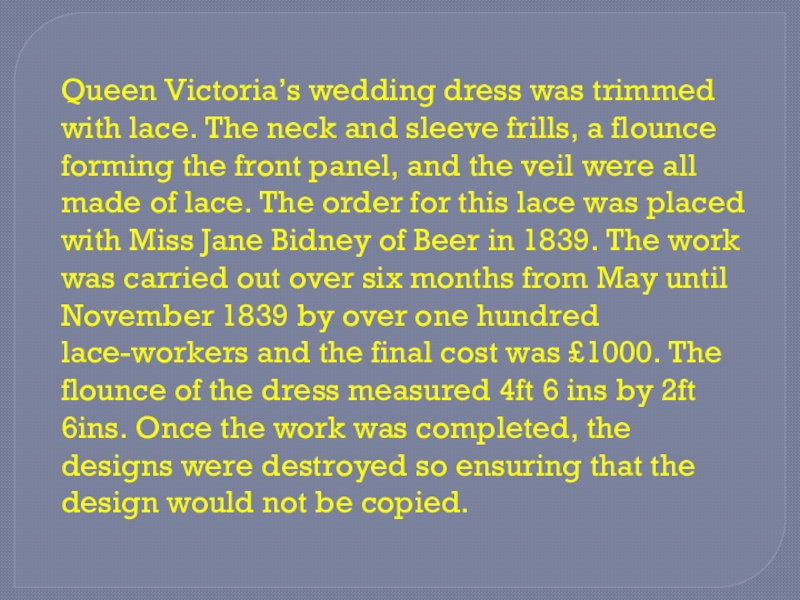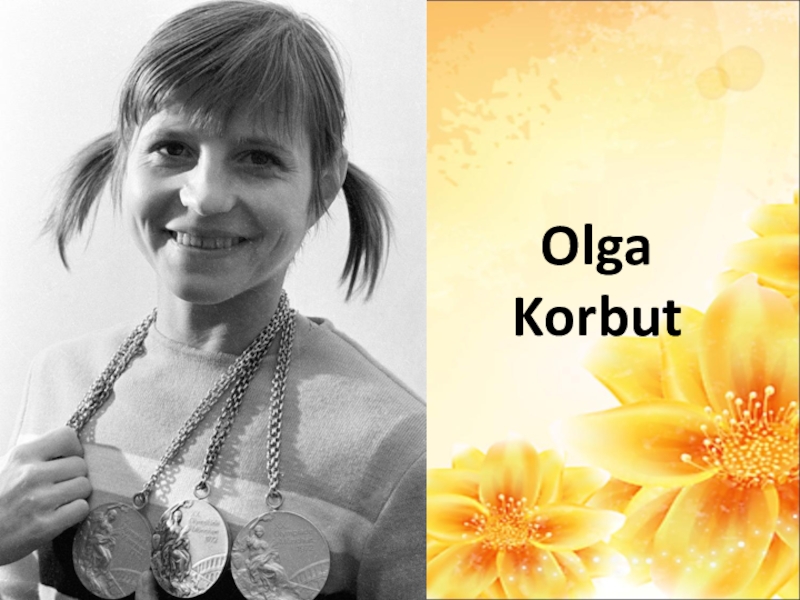OF GREAT BRITAIN
EAST DEVON
( HONITON )
- Главная
- Разное
- Образование
- Спорт
- Естествознание
- Природоведение
- Религиоведение
- Французский язык
- Черчение
- Английский язык
- Астрономия
- Алгебра
- Биология
- География
- Геометрия
- Детские презентации
- Информатика
- История
- Литература
- Математика
- Музыка
- МХК
- Немецкий язык
- ОБЖ
- Обществознание
- Окружающий мир
- Педагогика
- Русский язык
- Технология
- Физика
- Философия
- Химия
- Шаблоны, фоны, картинки для презентаций
- Экология
- Экономика
Презентация, доклад к теме Хобби THE LACE OF GREAT BRITAIN EAST DEVON (HONITON)
Содержание
- 1. Презентация к теме Хобби THE LACE OF GREAT BRITAIN EAST DEVON (HONITON)
- 2. Слайд 2
- 3. Devonshire, or Devon (the English Devonshire reduced
- 4. Honiton LaceLace making was for hundreds of
- 5. This wedding dress from 1865 is trimmed with Honiton lace.
- 6. Queen Victoria’s wedding dress was trimmed with
- 7. antique.lace.
- 8. Devon Attractions
- 9. Слайд 9
- 10. Honiton lace edging
- 11. Devon lace experts pass on centuries-old skills to Textiles students
- 12. Honiton lacemakers Honiton lace may no longer
- 13. The makers shared their expert knowledge of
- 14. Слайд 14
- 15. Слайд 15
- 16. Слайд 16
- 17. The Lace Museum:The best place to see
- 18. Honiton Museum, or, to give it its
- 19. Слайд 19
- 20. Слайд 20
- 21. Слайд 21
- 22. Слайд 22
- 23. The Allhallows Museum The Allhallows Museum, in
- 24. The Lace Shop The Lace Shop, in
- 25. Слайд 25
Devonshire, or Devon (the English Devonshire reduced by English Devon [dɛvən]) — the county in southwest England. The population of 1,102 million people (the 11th place among the nemetropolnykh of counties, given 2004). The capital —
Слайд 1Презентация выполнена преподавателем английского языка «Нижегородского Губернского колледжа» Кузнецовой С.И.
THE LACE
Слайд 3Devonshire, or Devon (the English Devonshire reduced by English Devon [dɛvən])
— the county in southwest England. The population of 1,102 million people (the 11th place among the nemetropolnykh of counties, given 2004). The capital — Exeter, the largest city — Plymouth. Devon makes potatoes, cereals, vegetables; it is rich with tin, copper (over 35000 tons annually), manganese, iron, silver, coal, marble, slates and different grades of clay. Fishery and shipbuilding is very developed. It is a lot of good harbors, especially on the southern coast.
Слайд 4Honiton Lace
Lace making was for hundreds of years, the main industry
of the town. Honiton had a large population of lace-makers - women who would sit outside their houses using the bright sunlight to weave highly complicated and delicate pieces.
Lace making was an extremely labour intensive craft, with even the smallest piece requiring a high degree of skill and precision to make. Eventually, machine made lace products became a cheaper alternative - causing Honiton's lace making industry to go into a decline.
In 1841, lace makers from the Honiton area were commisioned to supply lace for Queen Victoria's wedding dress. The Queen was so impressed by the quality of the work, so she commisioned a second piece as a christening robe of her eldest son, later to be King Edward VII. This delicately woven lace gown is still in use today.
Lace making was an extremely labour intensive craft, with even the smallest piece requiring a high degree of skill and precision to make. Eventually, machine made lace products became a cheaper alternative - causing Honiton's lace making industry to go into a decline.
In 1841, lace makers from the Honiton area were commisioned to supply lace for Queen Victoria's wedding dress. The Queen was so impressed by the quality of the work, so she commisioned a second piece as a christening robe of her eldest son, later to be King Edward VII. This delicately woven lace gown is still in use today.
Слайд 6Queen Victoria’s wedding dress was trimmed with lace. The neck and
sleeve frills, a flounce forming the front panel, and the veil were all made of lace. The order for this lace was placed with Miss Jane Bidney of Beer in 1839. The work was carried out over six months from May until November 1839 by over one hundred lace-workers and the final cost was £1000. The flounce of the dress measured 4ft 6 ins by 2ft 6ins. Once the work was completed, the designs were destroyed so ensuring that the design would not be copied.
Слайд 12Honiton lacemakers Honiton lace may no longer be made commercially, but the
tradition
has been kept alive by local lacemakers. Pat Perryman is a teacher with
a reputation which attracts lacemakers from all over the south west of
England to her weekly Tuesday classes, held at the Community College
in Honiton. She also runs residential courses for students from all over
the world and travels herself, to teach Honiton
lacemaking, in this country and abroad. Her
lace school for children is continuing a
tradition with its roots in the early lace schools
of the seventeenth century. With past pupils
acting as helpers she is ensuring that the skills
of lacemaking continue well into the future.
Слайд 13The makers shared their expert knowledge of Honiton Lace in practical
sessions and also taught students the history of lace - such as how techniques haven't changed since the 1500s and how changes in technology have meant that it's no longer practised commercially.
Слайд 17The Lace Museum:
The best place to see examples is the Allhallows Museum
of Lace and Local Antiquities.
The museum, in the former chancel of a church, has one of the world's most complete collections of this lace, with examples dating from the 16th to the early 20th century when commercial production finally ended.
The museum, in the former chancel of a church, has one of the world's most complete collections of this lace, with examples dating from the 16th to the early 20th century when commercial production finally ended.
Слайд 18Honiton Museum, or, to give it its full title, Allhallows Museum
of Lace and Antiquities, is located in the oldest building in Honiton. Allhallows boasts the largest collection of Honiton lace in the world, and has an astonishing wealth of local heritage information packed into a small historic building.
Слайд 23The Allhallows Museum The Allhallows Museum, in the High Street in Honiton,
has an
excellent display of Honiton lace, arranged chronologically so that its
history can be appreciated. The display includes some impressive and
important pieces with a provenance. Life size mannequins wearing lace
trimmed costumes and accessories allow the visitor to see how Honiton
lace was worn. Displays of other types of lace allow comparison and
there are cabinets with historical lace making equipment and summer
demonstrations of lacemaking. The museum, which is housed in a
thirteenth century chapel and an eighteenth century school dining hall,
also displays Honiton pottery, archaeological finds from the local area
and relics of the early school. The museum is open from April until the
end of October. Telephone: Museum 01404 44966.
Слайд 24The Lace Shop The Lace Shop, in the High Street, (see page
95) has a fine display
of antique Honiton lace and a comprehensive selection of all types of
European lace from the sixteenth century to around 1900. Also
available are framed sprigs of Honiton lace and lace mounted as paper-
weights, pendants, brooches and trinket boxes. Antique bobbins are also
available. Owned by Jane Page and managed by her son Jonathan, the
Lace Shop also offers a cleaning and restoration service. The shop has
an attractive bridal department where antique wedding veils are
displayed. Prospective brides can see and try on veils, from full length
versions, to smaller bonnet veils.
Lacemakers can buy lacemaking equipment and books, whilst
tourists are catered for with an exclusive design of white Honiton
motifs on a blue background, found on all kinds of items including bags
and aprons. Other gift items such as prints of lacemaking, charms in
silver, thimbles and pincushions are available.


![Презентация к теме Хобби THE LACE OF GREAT BRITAIN EAST DEVON (HONITON) Devonshire, or Devon (the English Devonshire reduced by English Devon [dɛvən]) Devonshire, or Devon (the English Devonshire reduced by English Devon [dɛvən]) — the county in southwest England.](/img/thumbs/fa5ae0b780541a1377536907903587a4-800x.jpg)



























